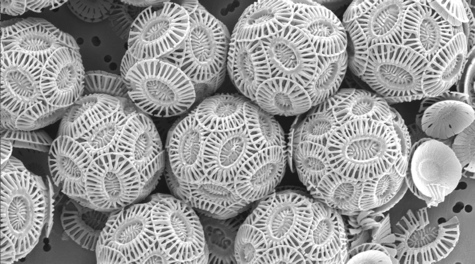You may ask – “what are protozoans?” It’s a good question. The breakdown of the word includes “proto” which means “before”, and “zoan” which refers to animals. These are the “before animals” – meaning animal-like creatures BEFORE there were true animals.
They are single celled creatures that lack a cell wall and chlorophyll – animal-like – but they are only single celled – so, not true animals. Being animal-like means they cannot produce their own food as the diatoms, dinoflagellates, seaweeds, and true plants do. Rather, they must consume food as animals do. Some feed on diatoms and dinoflagellates. Some feed on decaying organic matter from the seafloor. Some are parasitic and feed off a host organism. Some feed on other protozoans. And some do a combination. But they are all consumers.
The group is classified into six phyla mostly based on how they move. One subphylum is the Mastiogophorans – which move using flagella. Flagella are long whip-like tails that extend from the cell and can “twirled” in a fashion that will help the cell move around in the environment. Flagellates can have one or many flagella. Most are not free-swimming in the water column but live on the bottom or are parasitic. Two groups common in marine waters are the choanoflagellates and the coccolithophores.
Choanoflagellates are cells that usually possess one flagella that is protected by a funnel shaped structure called a collar. They are often called “collar cells”. Though found in many benthic environments they are most famous for their role in sponges. Here they live within the walls of the sponge, twirling their flagella to generate a current that draws water into the sponge for feeding. The currents generated by the choanoflagellates also move waste and reproductive gametes out of the sponge into the environment.
Coccolithophores are flagellated protozoans covered by calcium carbonate plates. These are more common in the plankton of the Gulf of Mexico and play an important role in the carbon cycle. They convert CO2 into calcium carbonate, and other forms of carbon, reducing the CO2 levels in both the atmosphere and ocean, that plays a role in ocean acidification.

Coccolithophores are flagellated creatures covered in calcium carbonate plates.
Image: National Oceanic and Atmospheric Administration.
An interesting note here… when I was in college, we studied the dinoflagellates in both marine botany AND marine invertebrate zoology. I was quite confused… are they “plant-like” or “animal-like”? They could not be both… When I asked my marine botany professor she was adamant, they were part of the “plant world”. But my marine invertebrate zoology professor felt the same – they were definitely in the animal world. They both mentioned this was why they were listed in their own phylum and agreed to disagree. Dinoflagellates (which we have already covered in this series) do photosynthesize, and they do consume other plankton. The same is true for coccolithophores. A quick look on the internet they were described as “phytoplankton” not “zooplankton”. I am including them here – and know they are called coccolithophores. I also know they are one of the creatures found in the northern Gulf of Mexico.
References
Yaeger, R.G. 1996. Protozoa: Structure, Classification, Growth, and Development. Chapter 77. Medical Microbiology, 4th edition. https://www.ncbi.nlm.nih.gov/books/NBK8325/#A4082.
- Rattlesnakes on Our Barrier Islands; Part 4 – Thermoregulation - December 29, 2025
- Rattlesnakes on Our Barrier Islands; Part 3 – Envenomation - December 22, 2025
- St. Joe Red Tide Claiming Terrapins - December 15, 2025
